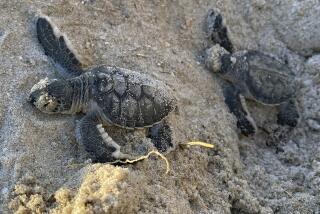Endangered Sea Turtles Battle for Survival at New England Aquarium
- Share via
BOSTON — The patient flails wildly as it is lifted out of a blue plastic box and onto an examination table in the critical-care ward at the New England Aquarium.
The young sea turtle, with big, baleful eyes and a sharp beak, is named “Orange/yellow” for the band that has fallen off its flipper. The patient is a Kemps ridley, the most endangered sea turtle species in the world.
In November it was found washed up on a Cape Cod beach in a near-death state of hypothermia known as “cold-stunned,” one of dozens of rare young turtles stranded on the Cape each winter, unable to migrate south when the waters turn cold.
“They’re a lot easier [to handle] when they’re cold-stunned,” Kristen Patchett, a technician in the aquarium’s rescue and rehabilitation unit, said as she and a fellow technician calmed the turtle, weighed it, checked its eyes for responsiveness, measured its heart rate (48 beats a minute) and inspected its skin and shell for lesions and abrasions.
“Orange/yellow” is one of 25 turtles rescued this winter on Cape Cod beaches by Audubon Society volunteers and brought to the aquarium for emergency treatment. Eight of them recovered enough to be transferred to aquariums in Baltimore and Orlando, and another eight, including “Orange/yellow,” remain in the aquarium’s critical-care ward. The other nine died.
Cold-stunned turtles have trouble breathing and often end up floating at the ocean’s surface. But some sink to the bottom, unable to surface and thus unable to breathe. At the surface, the helpless turtles are battered by waves and the occasional boat. Some are swept to the beach, where the lucky ones are rescued. Others drift out to sea and die.
Some rescued turtles arrive at the aquarium in such a slowed metabolic state that they appear dead. Their heart rates can be detected only by ultrasound. Often they are severely dehydrated because they have stopped eating.
Too weak to swim when they arrive at the aquarium, the seagoing reptiles are kept out of the water in humid air. To keep them moist, a jelly is applied to their skin and ointment to their eyes. “It’s basically the equivalent of a hospital bed,” Patchett said of the treatment.
As cold-blooded reptiles, turtles’ body temperatures are closely affected by their surroundings. Rescued turtles show up at the aquarium with body temperatures far below the desired 75 or 80. Aquarium staffers warm them carefully over a few weeks because a quick temperature increase can further damage a turtle’s organs.
Little is known about sea turtles and scientists are not sure why they become stranded. But migration, ocean currents and distribution patterns play a role, the aquarium says. Kemps ridleys summer in the fertile waters of Cape Cod Bay. Most, but not all, head south for the winter.
“That’s the question. We really don’t know why they’re staying,” Patchett said.
Most of the stranded turtles are less than 5 years old, although it is impossible to tell the age of a turtle accurately or how long they live. It is also very difficult to tell whether a sea turtle is a male or female, Patchett says.
The Kemps ridley, one of seven known species of sea turtle, can weigh up to 100 pounds. Young “Orange/yellow” weighed just four pounds when it was found on South Sunken Meadow Beach in Eastham, Mass. It now weighs nearly seven pounds.
Scientists do not know how long Kemps ridleys live, but some speculate it can take decades before they are old enough to breed, said Bob Prescott, director of the Audubon Society’s Wellfleet Bay Wildlife Sanctuary, which coordinates turtle rescues on Cape beaches each winter.
Entanglement in fishing nets and poaching have devastated the Kemps ridley population. Trash on beaches and at sea can also be deadly to hungry turtles, Patchett says.
The population of Kemps ridleys has declined so steeply that females now lay their eggs on a single beach near Rancho Nuevo, Mexico. Patchett says there are an estimated 3,000 nesting females left in a habitat that stretches from the Gulf of Mexico to New England. In 1947 an estimated 47,000 females nested, the aquarium says.
But thanks to rescue efforts, there is still hope for endangered turtles. “Orange/yellow” is thriving and will soon be transferred to another aquarium in Florida. It will be released into the wild this spring.
More to Read
Sign up for Essential California
The most important California stories and recommendations in your inbox every morning.
You may occasionally receive promotional content from the Los Angeles Times.










